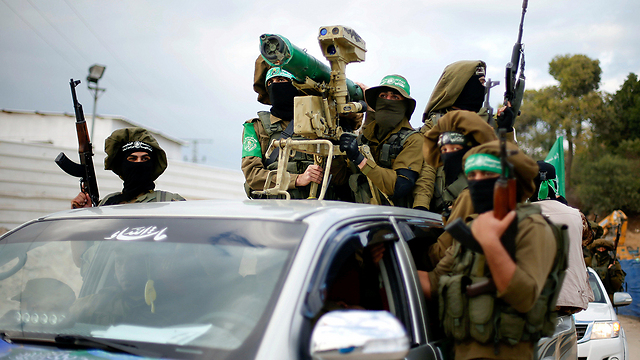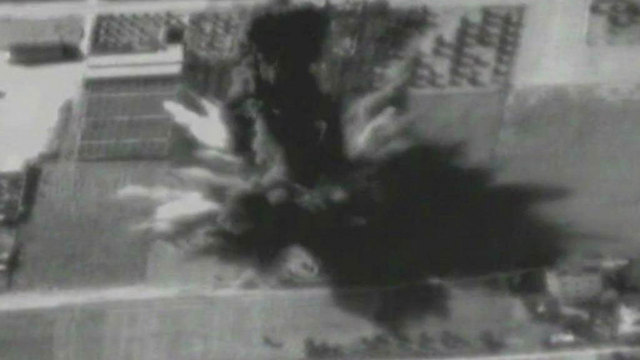

IDF: ‘We'll turn Hamas tunnels into their death trap'
IDF determined to deliver coup de grace to Hamas as it prepares for the next round of fighting by transforming their terror tunnel network into a weapon rather than merely a threat; military predicts Hamas will attempt to launch simultaneous infiltrations into Israel via tunnels to murder and kidnap Israelis as it endeavors to create an impression of victory from the outset.
The Israeli side is focusing on locating Hamas’ strengths and optimizing the selection of targets.
Hamas, on the other side of the fence, is preparing for the use of naval commandos and mini remotely-piloted vehicles, setting off daily sirens in the Tel Aviv metropolitan area and bringing thousands of fighters into the network of subterranean tunnels.
Standing several meters from the fence of Kibbutz Nahal Oz in the northern Gaza vicinity, one can easily see Hamas’ arms race and recovery taking place.
Palestinian tractors and trucks load construction material which has been recycled from what was left of the homes in the Shuja'iyya neighborhood are a common site.
The residents have not returned to the homes overlooking the fields and houses of Nahal Oz and Kibbutz Kfar Aza, and Gaza’s eastern neighborhood has turned into the largest concrete factory in the strip.
Meanwhile, Hamas posts are springing up like mushrooms after rain between the Palestinian villages and towns and the Israeli border. Under the fertile agricultural land on both sides of the border fence, the land is rustling with the sounds of diggings.
The sounds of Hamas’ combat training, the shooting ranges and fitness exercises can be heard clearly on the Israeli side, even in the middle of the night. Two and a half years after Operation Protective Edge, it seems that quite a lot has changed in the approach of both Hamas and the IDF.
“We plan to turn the enemy’s tunnels into death traps, into something that will stand in their way,” Colonel Yuval Ben-Dov, commander of the Southern Commands Fire Control Center, told Ynet. “The next battle won’t be just over aerial fire, and fire alone will not win the next war.”
The Southern Command is preparing for another conflict in Gaza, this time more accurate and less scattered in terms of munition volumes and explosives.
All these preparations are subject to the Defense Minister’s unequivocal policy to end the next war with a defeat to Hamas rather than buying two or three more years of calm.
Until that happens, every few months the IDF targets strategic assets built by Hamas using exceptional offensive planes that drop tons of ammunition from the air.
On paper, these sporadic strikes are carried out in response to a rocket fired at an Israeli community. In reality, they are launched in an effort to exploit the opportunity to weaken the recovery of Hamas’ military wing.
A conversation with Southern Command officers outlines the change in the IDF’s perception of strikes against Hamas, focusing on efficiency and speed.
IDF officials are realizing that the economic distress, which includes a drop in electricity and water supply and a high unemployment rate, along with sewer flooding and a population growth in a small and crowded area, are turning into a time bomb.
A source in the Southern Command told Ynet that “95 percent of the strip’s budget comes from the outside. Hamas understands that and is acting sensibly.”
In recent months, Hamas has arrested more than 30 rebellious activists who disobeyed its orders and fired rockets at Israel. It is taking other organizations in the strip, such as former Hamas or Islamic Jihad members, under its wings and helping them with training and money.
Hamas will place importance on kidnapping and murdering Israelis
In conversation with commanders for the Southern Command, it is clear that Hamas, like the IDF, will endeavor to fight in a more focused fashion in the next round. The terror organization is planning to carry out simultaneous surprise underground infiltrations via tunnel from which dozens of armed terrorists will emerge from the areas surrounding the Gaza Strip with the sole intent of murdering and kidnapping Israelis.
The emphasis placed on such a tactic is designed to create the impression of victory from the first day of fighting and show that the IDF is unprepared for the battle.
Hamas intends to allocate the majority of its fighting force to the underground sphere to which it wants to lure Israeli soldiers—a sphere which is growing every day.
Moreover, the organization is rearming and improving its rocket capabilities, placing particular priority on firing range as part of its overall strategy of ensuring that residents of the Tel Aviv area receive no respite from the sounds of the sirens, indifferent to the interceptions of the Iron Dome.
But in addition to Hamas’s thirst to wreak havoc on Israeli citizens by way of sound, it is also working to do so by pound—that is, by increasing the explosive impact of their rockets. Short-distanced mortars too are expected to cause greater damage which will be earmarked for communities near Gaza and areas containing IDF concentrations.
Drone attacks, coordinated from within the tunnels, are also expected to be carried out in the next round, as well as amphibious assaults from commando units launched from the sea. The overall strategy is to take the fight to Israel, rather than defend on home turf.
The strategies were already employed, with partial success, by Hamas during Operation Protective Edge in 2014. Whether they will be put to more effective use next time remains to be seen.


















